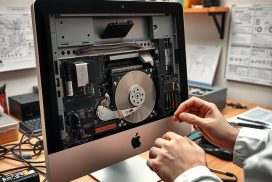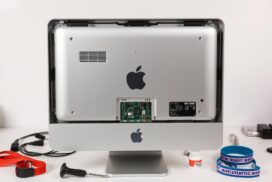A Guide to Repairing or Replacing Your iMac’s Graphics Card
Having trouble with your iMac’s graphics card is annoying and can slow down your computer. You might see weird lines, colours, or your screen might stop working. It’s important to know how to fix or swap your iMac’s graphics card. This guide will show you how to replace your iMac GPU the right way.
We will cover how to spot when your graphics card is failing and share easy ways to test it, such as starting your computer in safe mode. We will also discuss when it’s better to fix it or get a new one. Knowing which graphics cards will work with your iMac is key.
Starting to fix your iMac’s GPU issues might seem tough. Yet, with the correct guidance, you can decide whether to repair or replace it. We will take a closer look at these problems. This ensures your iMac keeps working well.
Understanding iMac Graphics Card Issues
Knowing when your iMac’s graphics card is failing is key. Various signs can show, impacting its performance. Catching these early helps avoid costly fixes.
Common Signs of GPU Failure
There are clear signs of a failing iMac graphics card. Issues include:
- Sudden shutdowns with graphic-heavy apps.
- White screens at startup, especially in the iMac 24″ 2008.
- Graphics artefacts like distorted images or lines on the screen.
- Crashes during gaming or graphic tasks.
- Screen flickering or odd colour patterns.
Older iMac models often show these symptoms. They had high failure rates in their GPUs.
Diagnosing Graphics Card Issues with Your iMac
Figuring out GPU problems means checking symptoms and performing tests. Starting in single-user or recovery mode helps identify the issue. This helps see if it’s the GPU or something else like the power supply.
Since 2007, MacKing has been fixing iMac problems, including GPU failures. The iMac 21.5″ and 27″ models from 2007 to 2011 often had these issues. Getting a professional check early can stop further problems.
How to Fix Graphics Card on iMac
Tackling graphics card issues on an iMac can be complex. Following the right steps for GPU troubleshooting helps users pinpoint problems and find solutions. These actions reveal if a hardware fix is needed or if it’s time for professional help.
Initial Troubleshooting Steps
Begin with these initial actions:
- Make sure all the graphics card and display connections are tight.
- Upgrade to the latest software version for your iMac.
- Delete caches and reset system settings.
- Use Apple Diagnostics to spot hardware issues.
- If external screens work fine, your iMac’s hardware might be the issue.
Booting into Safe and Single-User Modes
To see if software problems are to blame, boot into safe and single-user modes. Here’s how:
- For safe mode, turn off your iMac. Then turn it on while you press the Shift key. Let go when the Apple logo appears.
- For single-user mode, restart and press Command + S right after the startup sound. This mode, with no graphical interface, helps find the problem’s root.
Using iMac’s safe and single-user modes helps check if the issue is with software or hardware. This systematic troubleshooting can lead to diagnosing and maybe fixing iMac graphics card problems.
| Step | Action | Purpose |
|---|---|---|
| 1 | Check connections | Ensure all components are securely connected |
| 2 | Update software | Eliminate software compatibility issues |
| 3 | Run Apple Diagnostics | Identify hardware failures |
| 4 | Safe Mode | Determine if a software issue is present |
| 5 | Single-User Mode | Access a minimal environment to isolate problems |
Deciding Between Repair and Replacement
Having issues with your iMac’s graphics card can lead to a tough choice: repair it or get a new one? Think about the iMac’s age, if you can get parts, and the cost. Knowing these things helps you choose wisely.
Factors to Consider for Repair
Deciding to repair your graphics card means looking at important factors for GPU replacement. Here are the main things:
- Age of the iMac: Older iMacs may be harder to find parts for, making repair expensive.
- Cost of iMac GPU repair: Compare repair costs with the price of getting a new one carefully.
- Risk of Failure: Fixed parts might not last, especially in older models.
- Technical Expertise: Trying to fix it yourself without experience could cause more issues.
- Manufacturer Support: Check if there are any official repair offers or warranties to help with costs.
Cost-Effectiveness of Replacement
Looking into new graphics card prices can change your mind about repair costs. Let’s see how this adds up:
- Price of New Graphics Cards: New parts might be too expensive, more than fixing what you have.
- Used or Reconditioned Options: These might save money but check if they work with your iMac.
- Long-term Value: A new part could make your iMac last longer and work better than fixing it often.
- Repair Costs Transparency: Always ask for a clear cost breakdown for repairs.
In conclusion, think about the factors for GPU replacement and repair costs carefully. Understand your needs to make the best decision. Doing a thorough check ensures you get good value and avoid extra costs.
Choosing the Right Replacement Graphics Card for Your iMac
Looking for a new graphics card for an older iMac, especially ones from around 2010? It’s important to find compatible ones. There are many suitable graphics cards for iMac. But, some are only available second-hand. So, it’s crucial to do your homework to make sure the upgrade works.
Compatible Graphics Cards for Older Models
For iMacs made in 2010, AMD graphics cards are a great choice. They work really well with the software. The AMD WX4130 is a top pick, offering power similar to the AMD WX4150 and RX460. Upgrading your iMac’s graphics will cost between £75 and £100, making it an affordable way to boost your computer’s performance.
Pros and Cons of OEM vs PC Laptop Cards
Choosing between OEM and PC laptop graphics cards has its ups and downs. OEM cards are more reliable and work better with the software, reducing the risk of issues. Meanwhile, PC laptop cards might save you money. Yet, they may need special steps to work in iMacs. This includes using a special Linux setup and a clip-on USB tool to programme them.
Here’s a quick guide to the differences between OEM and PC laptop graphics options:
| Feature | OEM Graphics Cards | PC Laptop Graphics Cards |
|---|---|---|
| Reliability | High | Variable |
| Software Compatibility | Excellent | May Require Customisation |
| Cost | Moderate | Typically Lower |
| Installation Complexity | Relatively Simple | Higher (Custom Flashing Needed) |
Using OpenCore can also bring back important features like boot screens and brightness adjustments. It lets you install newer macOS versions after High Sierra too. If you need more graphics power, consider an external GPU (eGPU). This is especially good for Intel Macs with Thunderbolt 3. They work with macOS High Sierra 10.13.4 or newer. eGPUs help with professional work, 3D games, and making VR content.
Step-by-Step Guide to Replacing the Graphics Card
Replacing the iMac graphics card might seem tough. But, a structured iMac GPU installation guide can make it easier. We’ll go through a step-by-step GPU replacement method. This focuses on key steps needed for a smooth upgrade.
Preparing Your iMac for Repair
First, make sure the iMac is off and unplugged. Place it face-down on a soft, clean surface to avoid scratches. To lift the glass, use 3M “Command” adhesive coat hangers. They cost less than $5 and work well.
Accessing the Graphics Card
Begin by carefully removing the glass panel. Use the adhesive hangers for this. Next, unscrew the display using the necessary tools. There are ten T-10 torx screws on the logic board that need removal. These include both long (2.5mm x 24mm) and short screws (2.5mm x 7mm). Also, disconnect the 17 connectors to get to the graphics card. Apple uses different pins for each connector to help prevent mix-ups when putting things back together.
Installing the New Graphics Card
With the logic board out, it’s time for the new graphics card. You’ll need the part #661-5135 from Impact Computers in Florida. The graphics card is secured with two T-9 (2mm x 5mm) torx screws. To remove the card, tilt at 45 degrees and slide it out from the MXM connector. Don’t forget to connect the thermal sensor. For reassembly, simply reverse the steps you took apart. Before you put everything back, vacuum any dust that might have built up.
By following this guide on replacing the iMac graphics, anyone can feel confident during the process. It helps those not familiar with hardware upgrades to manage with assurance.
Additional Tips for Maintaining Your iMac’s Performance
Handling graphics card problems is step one. Next, we must look at keeping your iMac running well. Knowing the best iMac maintenance tips can stop it slowing down later. Doing regular upkeep helps the hardware last longer and work better.
Regular Maintenance Practices
Here are key habits for a smooth-running iMac:
- Check for Software Updates: It’s vital to always have the latest versions of macOS and your apps.
- Manage Storage Space: Make time to clear out files you don’t need. Look out for big photos, videos, and cache data.
- Monitor Startup Items: Stop unwanted apps from opening when your iMac starts. It helps with the system’s first load.
- Clear Cache Files: Cleaning out cache regularly makes more room and speeds up your iMac.
- Purge the Trash Bin: Don’t let old files pile up in the Trash. Clearing it helps.
- Restart Your iMac: Restarting can clear RAM and complete updates, which is good for your iMac.
Software Solutions to Monitor Performance
Using software for iMac performance monitoring lets you keep track of its health:
- Activity Monitor: This tool shows how your CPU, Memory, Energy, Disk, and Network are doing. It’s great for seeing where resources go.
- Schedule Regular Maintenance Checks: Setting up automatic checkups keeps you ahead of any issues.
- Monitor GPU Temperatures: Keep an eye on your graphics card temperature to avoid overheating and performance drops.
For extra ways to get your iMac running perfectly, look at this detailed guide. Using these tips will keep your iMac performing well. It ensures your system works without any hitches.
Conclusion
Fixing an iMac graphics card requires knowing potential problems, especially with a lot of use. Spotting signs early can help you decide if you need to fix or replace it. It’s crucial to keep up with GPU maintenance.
For a smooth running machine, regular cleaning is key. Using tools like Macs Fan Control helps prevent overheating. Also, make sure your software and drivers are up to date to avoid problems.
Knowing how to handle iMac graphics card repair empowers users. It allows them to keep their device in top shape. Getting professional help or doing simple fixes yourself can prevent major issues later.
FAQ
What are the common signs of graphics card failure in my iMac?
Common signs include sudden shutdowns, white screens at startup, and graphical artefacts. These symptoms suggest an issue with the graphics card that needs looking into.
How can I troubleshoot graphics card issues on my iMac?
To start troubleshooting, check all connections and update your software. Clearing caches is also a good step. Booting into safe mode or single-user mode can help. It shows if the problem is with software or hardware.
Should I repair or replace my iMac’s graphics card?
The decision between repair or replacement depends on cost, component availability, and your iMac’s age. For old models, replacing may not be cost-effective. It might be time to consider an updated system.
What types of replacement graphics cards are compatible with older iMac models?
Older iMac models, especially from 2010, have varied compatible graphics cards. Always ensure compatibility by checking specifications. Some cards may only be found used.
What are the advantages and disadvantages of using OEM graphics cards vs. PC laptop cards?
OEM graphics cards provide better reliability and software compatibility. PC laptop cards are often cheaper but might need custom flashing. They pose a higher risk for functionality and compatibility issues.
Can you provide a step-by-step guide for replacing a graphics card in my iMac?
To replace your iMac’s graphics card, start by unplugging and laying it face-down. Remove the glass panel and display to reach the GPU. Follow instructions carefully for screw types and connections. Then, put in the new card and reassemble your iMac.
What maintenance practices can I adopt to keep my iMac performing optimally?
To maintain your iMac, clean it regularly and check for software updates. Optimize your storage space. Use monitoring software to keep an eye on GPU temperatures and performance. This prevents overheating and maintains efficiency.













